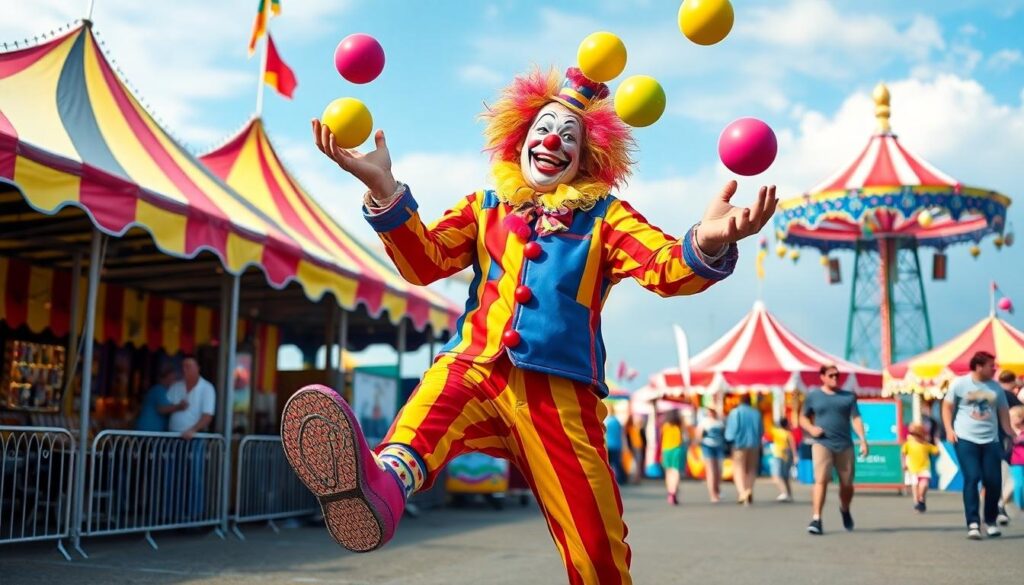Carnival jokes bring a special kind of laughter that transports us back to childhood fairgrounds filled with cotton candy, flashing lights, and the excited shrieks from roller coasters. We’ve gathered the funniest carnival-themed jokes that’ll have you reminiscing about those magical summer evenings spent trying to win oversized stuffed animals.
Whether you’re planning a carnival-themed party, working as a clown, or simply want to lighten the mood with some fairground humor, these jokes hit the mark. From carousel puns to funhouse one-liners, our collection covers everything that makes carnivals the perfect backdrop for comedy. Ready to step right up and discover jokes that are guaranteed to be more satisfying than those impossible-to-win carnival games?
The Art of Carnival Jokes: Making People Laugh at Fairs and Festivals
Carnival atmospheres create the perfect backdrop for humor and laughter. Mastering the art of carnival jokes requires understanding your audience and the festive environment around you. Timing plays a crucial role when delivering jokes at bustling fairs where distractions abound everywhere.
Professional carnival performers know that visual humor works exceptionally well in fairground settings. Props like oversized novelty items, silly hats, or colorful accessories can enhance your joke delivery and catch attention from across crowded midways. Reading the crowd helps determine whether family-friendly puns or slightly edgier humor will generate the best response.
Voice projection becomes essential when competing with carousel music and game barkers. Adjusting your volume without shouting demonstrates skill that seasoned carnival comedians develop over years of practice. Exaggerated facial expressions and body language communicate punchlines even to audience members who might not hear every word clearly.
Callback jokes work wonderfully in carnival settings by referencing earlier gags or observations about exact attractions. Interactive humor involving audience participation creates memorable experiences that visitors associate with their fair experience. Weather-related jokes about hot days or unexpected rain showers establish immediate rapport with carnival-goers experiencing the same conditions.
Customizing your material to include local references makes your jokes feel special to that particular event rather than generic carnival content. Short jokes typically perform better than lengthy stories since people are often moving between attractions. Practicing quick comebacks prepares you for unexpected situations or hecklers who might try to derail your performance.
Carnival joke delivery should match the energy of the surrounding environment without seeming forced or awkward. Maintaining a genuine smile throughout your performance conveys confidence and puts audiences at ease immediately. Building a repertoire of jokes customized to different carnival situations ensures you’re never caught unprepared regardless of circumstances.
Classic Carnival Joke Tactics That Never Fail to Entertain

The Squirting Flower Prank
The squirting flower prank remains one of the most iconic carnival joke props that continues to delight audiences across generations. This classic gag features a realistic-looking flower with a hidden water reservoir that’s designed to spray unsuspecting victims when activated. Carnival jokesters typically attach these deceptive blooms to their lapels, making them appear as innocent decorative accessories. Triggering the prank requires just a simple squeeze of a concealed bulb mechanism, resulting in a stream of water that catches people completely off guard. Many professional entertainers at circuses and carnivals have perfected this prank’s timing, often captivating in seemingly normal conversation before surprising their target with the unexpected spritz. The beauty of this prank lies in its simplicity and the genuine reactions of surprise it generates, making it a staple in carnival entertainment.
Funny Mirror House One-Liners
Funhouse mirror attractions provide the perfect opportunity for quick-witted humor that plays on the distorted reflections visitors see of themselves. Carnival comedians often take advantage of these warped images to deliver perfectly timed one-liners that highlight the absurd transformations. Visitors might hear jokes like “You look stretched out like rubber!” when standing before mirrors that elongate their appearance. Tall mirrors often prompt quips such as “I didn’t know I was that tall today!” while the compressing mirrors inspire comments about suddenly shrinking. Professional carnival entertainers frequently incorporate these mirror house jokes into their routines, customizing them to match each visitor’s exact reflection distortion. The spontaneous nature of these jokes works particularly well because they’re personalized to each visitor’s unique mirror experience, creating moments of shared laughter throughout the funhouse attraction.
Other Classic Carnival Jokes
Balloon dart games serve as fertile ground for humor, with operators often setting up exaggeratedly difficult targets that lead to hilarious interactions with participants. Carnival workers frequently use this opportunity to playfully tease contestants while encouraging them to keep trying. Magic shows represent another timeless form of carnival entertainment, featuring simple yet effective tricks like pulling rabbits from hats or making coins vanish before astonished audiences. These performances combine scripted jokes with sleight-of-hand techniques to maintain the crowd’s engagement throughout the show. The interactive nature of these attractions creates natural opportunities for humor that builds on the shared experience of carnival visitors. Professional entertainers understand that these classic joke tactics work because they tap into the lighthearted atmosphere that defines the carnival experience.
Carnival Barker Jokes That Draw Crowds to Game Booths

Carnival barkers are the masters of drawing crowds with their quick wit and captivating humor. These vocal entertainers use comedic tactics to lure passersby to game booths while setting the festive tone that makes carnivals memorable experiences.
Winning Prize Humor
Carnival operators love to poke fun at the prizes they offer, creating laughter that softens the blow of potentially disappointing winnings. “Congratulations! You’ve won a stuffed animal worth… all the tickets you just spent!” is a classic line that acknowledges the often inflated effort-to-reward ratio at carnival games. Game booth workers frequently joke about small prizes having outsized value, with lines like “Take home this goldfish—it’s practically a roommate!” making light of the modest nature of carnival winnings. These self-aware jokes actually enhance the experience, as patrons appreciate the honesty wrapped in humor rather than feeling deceived about prize quality.
Impossible Game Quips
The notoriously difficult nature of carnival games provides fertile ground for barkers’ humor. “Toss a ring? More like toss your dignity!” is a favorite line that acknowledges the challenge while encouraging participants to try anyway. Booth operators often use phrases like “This game’s fair—if you’re a Vegas magician!” to humorously hint at the skill level required. Money-focused jokes such as “Three tries for $5? Let’s call it a donation!” create a shared moment of understanding between barker and customer about the true nature of carnival economics. These quips serve a dual purpose: they defuse potential frustration while maintaining the playful atmosphere essential to carnival culture. Barkers regularly employ exaggerated descriptions of game difficulty, creating an irresistible challenge that draws competitive spirits to test their luck even though the acknowledged odds.
Food Vendor Jokes That Serve Up Laughs Along With Treats

Food vendors are as much a part of the carnival experience as the rides and games. These culinary comedians serve up humor alongside their delicious treats, creating memorable moments for hungry fairgoers.
Cotton Candy Wisecracks
Cotton candy, with its fluffy texture and sugary sweetness, provides perfect material for carnival comedy. Why did the cotton candy go to therapy? Because it was feeling a little “fluffy” emotionally! This light-hearted joke plays on the airy nature of this carnival staple while giving it human qualities.
Another crowd-pleaser involves a conversation between carnival food icons. What did the cotton candy say to the corn dog? “You’re stuck in a rut.” This clever quip references the corn dog’s predicament of being impaled on a stick while creating a relatable metaphor that works on multiple levels.
Funnel Cake Funnies
Funnel cakes, with their distinctive hole-filled appearance, inspire their own category of carnival humor. Why did the funnel cake go to the party? Because it was a “hole” lot of fun! This pun cleverly plays on the unique structure of this beloved fried treat.
Relationship humor also finds its way into funnel cake comedy. What did the funnel cake say when it ran into its ex? “You’re just a fried memory now.” This joke anthropomorphizes the dessert while creating a humorous take on post-breakup encounters that resonates with carnival-goers of all ages.
Carousel and Ride Operator Humor That Keeps Spirits High

The heart of carnival entertainment often comes from the witty banter and playful pranks of ride operators. These quick-thinking entertainers have mastered the art of using humor to enhance the carnival experience, creating memorable moments for visitors of all ages.
Prankster Operators
Ride operators have become famous for their perfectly timed pranks that catch unsuspecting guests off guard. Many operators build anticipation by pretending there’s a mechanical issue with the ride, checking safety harnesses with exaggerated concern, or announcing “technical difficulties” moments before launching the ride normally. These harmless deceptions result in priceless reactions from riders, ranging from nervous laughter to shocked expressions that often become the highlight of the carnival experience. Operators carefully gauge their audience, ensuring their pranks create fun rather than genuine distress, skillfully walking the line between surprise and comfort.
Witty Remarks
Carnival ride operators are masters of crowd engagement through clever commentary. Their arsenal of one-liners, delivered while people board or exit rides, helps maintain a lively atmosphere throughout the park. Operators might tease hesitant riders with gentle encouragement or congratulate brave participants with humorous certificates of courage. These verbal exchanges not only entertain the immediate riders but also amuse the waiting crowds, making the sometimes lengthy queue times feel shorter. The best operators develop signature phrases that become part of the ride’s identity, with visitors eagerly anticipating these verbal traditions as part of the complete carnival experience.
Roller Coaster Comedy
Humor reaches new heights on roller coasters, where operators capitalize on riders’ heightened emotions. Jokes about fear are particularly effective when delivered just before the big drop, with operators playfully warning riders to “hold onto your lunch—and anything else you don’t want to lose!” The stark contrast between terror and laughter creates a unique comedic experience that’s distinctly carnival. Operators might also point out the ride’s most challenging sections with exaggerated warnings or fabricate statistics about previous “incidents,” leaving riders wondering if they’re joking just as the coaster begins its descent.
Ferris Wheel Wisecracks
The slower pace of Ferris wheels provides the perfect setting for longer-form jokes and observational humor. Operators frequently play on the height element, making comments about spotting distant landmarks or jokingly offering binoculars to see neighboring states. “You’re now officially on top of the industry—at least for the next 30 seconds!” has become a classic line delivered at the wheel’s apex. Another common theme revolves around the wheel’s circular motion, with operators quipping about passengers being “stuck in a loop” or experiencing “the roundabout way” of seeing the carnival. These height and rotation jokes have become such carnival staples that regular attendees often anticipate and even participate in the familiar banter.
Clown Jokes That Bring Smiles to Carnival Attendees

Clowns stand at the heart of carnival entertainment, using their unique brand of humor to create unforgettable moments for visitors of all ages. Their comedic talents transform ordinary carnival experiences into extraordinary memories through carefully crafted jokes and physical comedy.
Physical Comedy Masters
Clowns excel at physical comedy, employing exaggerated movements and slapstick humor that resonates with carnival audiences. Their over-the-top pratfalls, comical trips, and dramatic reactions create visual humor that requires no translation. Performers often use their entire bodies as comedic instruments—from rubber-legged walks to impossible balancing acts—captivating audiences through pure visual entertainment. These physical gags work perfectly in the bustling carnival environment where verbal jokes might get lost in the noise and excitement of the fairgrounds.
Interactive Humor That Engages
The best carnival clowns turn spectators into participants through interactive comedy routines. They’ll pull unsuspecting audience members into their acts for impromptu comedy duets, creating personalized experiences that attendees remember long after the carnival ends. Clown car routines demonstrate this interactive approach brilliantly, as performers impossibly squeeze into tiny vehicles before emerging in seemingly endless numbers. These participatory elements of clown humor build a connection between performer and audience that enhances the overall carnival atmosphere of community and shared joy.
Balloon Animal Punchlines
Balloon animals serve as both visual props and joke delivery systems in the skilled hands of carnival clowns. Creative balloon artists twist colorful inflatables into recognizable shapes that become instant conversation starters and joke setups. Dogs, giraffes, and monkeys emerge from simple balloons, often accompanied by puns like “This dog is a real airhead!” or “Why did the balloon snake go to the doctor? He needed a hiss-terectomy!”
Professional balloon twisters use their creations as comedy props, having balloon animals “interact” with audience members in playful, harmless ways. These visual punchlines work particularly well with younger carnival-goers, who delight in the combination of physical object and verbal humor. The anticipation of watching a balloon transform while enjoying the accompanying commentary creates a multi-sensory comedy experience unique to carnival environments.
Face Painting Humor
Face painting stations become hotspots for humor at carnivals as artists combine their creative skills with playful banter. Painters incorporate humorous designs into their repertoire, including clown noses, exaggerated eyebrows, and comically large mustaches that transform attendees into walking visual jokes. The transformation process itself becomes entertaining as artists make funny observations about their works-in-progress.
Face painters often develop signature jokes that complement exact designs, creating a complete entertainment package. “Hold still—unless you want to look like you’re winking at everyone all day!” they might quip while painting a butterfly. Many professionals use mirrors strategically, timing the reveal for maximum comedic effect and capturing delighted reactions. This combination of artistic skill and humor creates memorable interactions that enhance the overall carnival experience, leaving guests with both temporary artwork and lasting smiles.
Family-Friendly Carnival Jokes for All Ages

Here’s our collection of carnival jokes that will bring smiles to everyone in the family, from the youngest carnival-goers to parents looking for clean humor to share during your next fair visit.
Kid-Appropriate Riddles
- Why did the clown go to school? To improve his joke skills!
- What do you call a carnival ride that tells jokes? A “punch” line!
- Why don’t carnival games ever get lost? They always know how to “ring” the bell!
- What did the Ferris wheel say to the carousel? I’m “spinning” for you!
Parent-Pleasing Puns
- Why was the Mardi Gras clown so funny? Because he had a lot of JESTER-tude!
- Why did the magician get kicked out of the carnival? He kept “vanishing” into thin air!
- What did the balloon say to the clown? “I’m just here to inflate your ego!”
- Why was the carnival so popular? It had a lot of “attraction”!
- Why did the ticket booth go broke? It lost its “interest”!
- Why do vegetarians like carnival? Because they love the beets.
- Why was the potato so happy during the parade? He was made for chippin’.
How to Deliver Carnival Jokes With Perfect Timing

Reading Your Audience
Delivering carnival jokes successfully starts with understanding who’s standing in front of you. We recommend assessing the demographics of your cruise or carnival audience first, as crowds often include diverse age groups that respond best to universal themes. Jokes about travel mishaps or ship quirks like “Why couldn’t the cruisers play cards? Because they were standing on the deck!” tend to work well across different audiences.
Gauge engagement levels by testing observational humor before diving into your main material. For instance, a joke like “The ice cream truck in my neighborhood plays Helter Skelter” can help you measure audience responsiveness. Their reactions will signal whether you should continue with similar content or pivot to something different.
Always avoid sensitive topics that might trigger anxieties exact to your setting. Cruise audiences might not appreciate seasickness jokes unless you’ve established that self-deprecating humor lands well with them. Focus instead on shared experiences that create connection rather than discomfort.
Adjusting Your Delivery Style
Pacing makes all the difference when delivering carnival jokes. We’ve found that one-liners work best when delivered briskly to maximize the surprise factor. Try jokes like “Cross country skiing is great if you live in a small country” to see quick reactions. Strategic pauses before punchlines add emphasis to jokes such as “What did one ocean say to the other? Nothing, it just waved.”
Your tone should match the energy level of your audience. Playful teasing works wonders with casual crowds, while dry wit often resonates with older audiences. Steven Wright’s style of humor—”I saw a subliminal advertising executive, but only for a second”—demonstrates how deadpan delivery can be just as effective as animated performances.
Physical comedy enhances verbal jokes significantly in carnival settings. Exaggerated gestures that mimic scenarios like holding onto a hat in high winds on a cruise deck can transform a decent joke into a memorable moment. These physical elements help audiences visualize the humor and connect more deeply with your performance.
Pre-test your material using low-risk humor such as puns or light absurdism before attempting edgier content. This approach helps you understand boundaries without risking audience alienation. Adapting in real-time proves crucial if a joke underperforms—simply pivot to audience-exact details like “This ship’s buffet could solve industry hunger” to recapture attention.
Authenticity trumps forced theatrics every time. We’ve observed that audiences respond more positively to natural delivery that feels conversational rather than rehearsed. Developing your unique style allows your personality to shine through, creating genuine connections that enhance the impact of your carnival jokes.
Creating Your Own Carnival Jokes: Tips from Professional Entertainers

Professional carnival entertainers know that crafting the perfect joke requires skill and practice. We’ve gathered expert advice to help you create your own carnival-themed humor that will have audiences rolling with laughter.
Play on Words and Double Meanings
Word play forms the foundation of many successful carnival jokes. Professional entertainers recommend focusing on:
- Creating oxymorons that surprise the audience, such as calling a carnival ride a “punch line” because it tells jokes
- Developing puns related to carnival attractions, like those involving carousel horses or funhouse mirrors
- Using double entendres that are family-friendly yet clever enough to make adults chuckle
Master the Art of Exaggeration
Carnival humor thrives on making small things seem enormous or vice versa. Professionals suggest:
- Amplifying mundane details about carnival experiences for comedic effect
- Creating contrasts between expectations and reality, like joking about “jumbo mini donuts” that pack a big punch
- Stretching the truth about carnival games or prizes to highlight their notorious difficulty
Incorporate Cultural References
Seasoned entertainers know that connecting jokes to recognizable carnival figures enhances their impact. Try:
- Building jokes around clown characters and their signature behaviors
- Referencing carnival foods like cotton candy or funnel cakes in unexpected ways
- Including carnival ride names in punchlines to create instant recognition
Timing and Audience Interaction
The delivery of carnival jokes matters as much as their content. Professional entertainers emphasize:
- Adapting your humor to current events or pop culture references
- Captivating directly with audience members to create personalized jokes
- Allowing proper pauses before delivering punchlines for maximum impact
Test and Refine Your Material
Even the most experienced carnival entertainers continuously improve their jokes. They recommend:
- Practicing new material with small audiences before using it widely
- Observing which jokes receive the strongest reactions and building on those themes
- Collecting feedback from diverse age groups to ensure broad appeal
By following these professional tips, you’ll develop carnival jokes that capture the festive spirit and create memorable moments of laughter for audiences of all ages.
The Best Carnival Jokes to Remember for Your Next Fair Visit
Carnival jokes bring the vibrant energy of fairgrounds to life through laughter. We’ve explored how these quips entertain crowds from food stands to thrill rides and clown performances.
The magic lies in delivery—timing your jokes perfectly while reading your audience ensures maximum chuckles. Whether you’re telling cotton candy puns or mimicking a carnival barker’s exaggerated pitch you’re participating in a tradition as colorful as the midway itself.
Next time you visit a carnival don’t just enjoy the rides and games. Listen for the humor around every corner or try sharing a few jokes yourself. After all carnival humor isn’t just about the punchlines—it’s about creating those unforgettable moments of joy that keep us coming back year after year.
Frequently Asked Questions
What makes carnival jokes unique?
Carnival jokes are unique because they tap into the nostalgic atmosphere of fairgrounds and incorporate elements specific to the carnival experience. They often reference rides, games, food, and characters like clowns and barkers. The best carnival jokes blend observational humor with playful exaggeration, creating laughter that complements the festive environment.
How can I deliver carnival jokes effectively?
To deliver carnival jokes effectively, understand your audience, project your voice over carnival noise, use timing and visual props, and match the festive energy. Reading crowd reactions helps you adjust your material. Practice callback jokes and interactive humor for memorable experiences. Most importantly, be genuine and prepared for unexpected situations with quick comebacks.
What are some classic carnival joke tactics?
Classic carnival joke tactics include the squirting flower prank, funhouse mirror one-liners based on distorted reflections, balloon dart game jokes, and simple magic trick humor. These tactics work because they capitalize on surprise elements, visual distortions, and the shared experience of carnival attractions, creating interactive moments of laughter.
How do carnival barkers use humor?
Carnival barkers use quick wit and captivating humor to draw crowds to game booths. They often poke fun at their own modest prizes, use self-aware humor about game difficulty, and employ exaggerated descriptions with playful quips. This creates a shared understanding with patrons while maintaining a fun atmosphere that encourages participation despite the challenges.
What types of jokes do food vendors use at carnivals?
Food vendors at carnivals create humor around their signature treats, particularly cotton candy and funnel cakes. Cotton candy jokes play on its fluffy texture and appearance, while funnel cake humor includes puns about its distinctive shape and often incorporates relationship themes. These culinary comedians enhance the food experience with light-hearted banter while serving their delicious treats.
How do ride operators incorporate humor into the carnival experience?
Ride operators enhance the experience with witty banter and playful pranks like pretending to have mechanical issues before launching rides. They deliver perfectly timed jokes during ride operations and use clever commentary that engages both riders and waiting crowds. Their humor helps build anticipation and adds entertainment value to the waiting experience.
What makes clown humor special at carnivals?
Clown humor at carnivals is special because it combines physical comedy with interactive routines that directly engage spectators. Clowns use exaggerated movements, slapstick humor, and props like balloon animals to deliver punchlines. Their unique brand of comedy creates unforgettable moments through personalized experiences, making them central to carnival entertainment.
Where can I find family-friendly carnival jokes?
Family-friendly carnival jokes can be found throughout this article, particularly in the section dedicated to all-ages humor. Look for kid-appropriate riddles and parent-pleasing puns that reference carnival elements. These jokes are designed to bring smiles to everyone in the family, making them perfect for sharing during your next fair visit.
How can I create my own carnival jokes?
Create your own carnival jokes by using wordplay, exaggeration, and cultural references that relate to carnival experiences. Observe carnival activities for inspiration, master your timing, and engage directly with your audience. Practice your material in different settings and be open to refining it based on reactions. Focus on developing jokes that capture the festive spirit of carnivals.
What topics should I avoid when telling carnival jokes?
When telling carnival jokes, avoid sensitive topics that might alienate certain groups or age ranges. Steer clear of offensive stereotypes, political controversies, or adult themes when performing in family settings. Instead, focus on observational humor about shared carnival experiences, lighthearted wordplay, and self-deprecating jokes that everyone can enjoy together.







